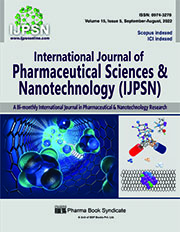Cytotoxicity Testing of Tinospora cordifolia Extracts against Human Kidney Cancer Cell Line
DOI:
https://doi.org/10.37285/ijpsn.2022.15.5.5Abstract
Background: Anti-cancer effects of medicinal plant products are mentioned in the ancient texts of Ayurveda. Currently, they have been studied at experimental and clinical levels in reverse pharmacology mode. Tinospora cordifolia wild is the most widely used for its medicinal properties in Ayurveda. It has been reported for having anticancer potential in many cancers.
Aim: The aim of the study is to explore the anticancer potential of Tinospora cordifolia Wild extracts against human kidney cancer cell lines.
Materials and Methods: Methanolic extracts leaf and stem of Tinospora cordifolia were obtained by soxhlet extraction. Both the extracts were analyzed for phytochemical screening. Both the extracts along with marker berberine were assessed for their cytotoxicity using the sulforhodamine B assay method against a 786-O human renal cell carcinoma cell line. Statistical analysis was done by Two way (ANOVA) followed by Bonferroni’s Post hoc test.
Results: Tinospora Cordifolia leaf and stem extracts and berberine showed highly significant cytotoxic activity as compared to control.
Conclusion: Therefore, Tinospora cordifolia can be considered as a potential medicinal plant with anticancer activity against human kidney cancer.
Downloads
Metrics
Keywords:
Kidney cancer, Tinopsora cordifolia, cytotoxicity testing, gulvel, SRB assay, Guduchi, 786-O cell linesPublished
How to Cite
Issue
Section
References
Asthana J, Jain S, Mishra A, Vijaykanth M (2001). Evaluation of antileprotic herbal drug combinations and their combination with dapsone. Indian Drugs 38: 82-86.
Bharathi C, ReddyA, Nageswari G, Sri Lakshmi B, Soumya M, Vanisri D, Venkatappa B (2018). A review on medicinal properties of Tinospora Cordifolia. International Journal of Scientific Research and Review 7: 585-598.
Bishayi B, Roychowdhury S, Ghosh S, Sengupta M (2002). Hepatoprotective and immunomodulatory properties of Tinospora cordifolia in CCl4 intoxicated mature albino rats. The Journal of Toxicological Sciences 27: 139-146.
Desai G, et al. (2008). Medicinal plants and cancer chemoprevention. NCBI 9: 581-591.
Duffy R, Wade C, Chang R (2012). Discovery of anticancer drugs from antimalarial natural products: a medline literature review. Drug Discovery Today 17: 942-53.
Ikram M, Khattak S, Gilani S (1987). Antipyretic studies on some indigenous Pakistani medicinal plants II. Journal of Ethnopharmacology 19: 185-192.
Indian Pharmacopoiea (2018). Govt. of India Ministry of Family and Health Welfare, Volume-III; pp 3795.
Jagetia G, Rao S (2006). Evaluation of the antineoplastic activity of guduchi (Tinospora cordifolia) in ehrlich ascites carcinoma bearing mice. Biological and Pharmaeutial Bulletin 29: 460-466.
Jana U, Chattopadhyay RN, Shw BP (1999). Preliminary studies on anti-inflammaory activety of Zingiber officinale Rosc., Vitexnegundo Linn. and Tinospora cordifolia (Willid) Miers in albino rats. Indian Journal of Pharmacology 31: 232.
Kalikar MV, Thawani VR, Varadpande UK, Sontakke SD, Singh RP and Khiyani RK (2008). Immunomodulatory effect of Tinospora cordifolia extract in human immunodeficiency virus positive patients. Indian Journal of Pharmacology 40: 107–10.
Khandelwal KR and Sethi V (2008). Practical pharmacognosy techniques and experiments, 27th Edition: pp 25.1-25.9.
Kirtikar KR, Basu BD Bishen Singh Mahendra Pal Singh (1975). Indian medicinal plant. 2nd ed , vol I, Deheradun, pp 499–502.
Nadkarni KM, Nadkarni AK (1976). Indian Materia Medica. Popular prakashan private Limited Mumbai.
Nayampalli S, Desai NK, Ainapure SS (1986). Antiallergic properties of Tinospora cordifolia in animal models, Indian Journal of Pharmacology 18: 250.
Nayampalli SS, Ainapure SS, Samant BD, Kudtarkar RG, Desai NK, Gupta KC (1988). A comparative study of diuretic effects of Tinospora cordifolia and hydrochlorothiazide in rats and a preliminary phase I study in human volunteers. Journal of Postgraduate Medicine 34: 233.
Patel MB, Mishra S (2011). Hypoglycemic activity of alkaloidal fraction of Tinospora cordifolia. Phytomedicine 18: 1045-1052.
Prajwala B (2018). In vitro anti-bacterial activity of Tinospora cordifolia leaf extract and its phytochemical screening. Journal of Biomedical Sciences 5: 10-17.
Rani J, et al (2015). Preliminary phytochemical analysis of different solvent extracts from leaf and stem of Tinospora cordifolia. International Journal of Phytotherapy 5: 124-128.
Rege N, Bapat RD, Koti R, Desai NK, Dahanukar S (1993). Immunotherapy with Tinospora cordifolia: A new lead in the management of obstructive jaundice. Indian Journal of Gastroenterology 12: 5-8.
Sangeetha Mk, Priya CD, Vasanthi HR (2013). Anti-diabetic property of Tinospora cordifolia and its active compound is mediated through the expression of Glut-4 in L6 myotubes. Phytomedicine 20: 246-248.
Singla A, Akant P, Singla P (2010). Review of biological activities of Tinospora cordifolia. Webmed Central Pharmaceutical Sciences, 1: 9.
Sunanda SN, Desai NK, Ainapure SS (1986). Antiallergic properties of Tinospora cordifolia in animal models. Indian Journal of Pharmacology 18: 250.
The Ayurvedic Pharmacopoeia of India, Govt. of India Ministry of Family and Health Welfare, Part-I, Volume-I, pp-41.
Tracy W, Rick A, Mamta K (2021). Key statistics about kidney cancer available on https://www.cancer.org/cancer/kidney-cancer/about/key-statistics.
Vashist N, Drabu S, Nand P, Arora P (2011). Treatment strategies for monkey malaria. Research Journal of Pharmaceutical Biological and Chemical Sciences 2: 478-87.
Vasudevan D, Sreekumari S (1995). Text book of biochemistry for medical students. Jaypee Brothers Medical, New Delhi.
Vichai V and Kirtikara K (2006). Sulforhodamine B colorimetric assay for cytotoxicity screening. Nature Protocols 1: 1112 - 1116
Zhao TF, Wang X, Rimando AM, Che C (1991). Folkloric medicinal plants: Tinospora sagittata var. Cravaniana and Mahonia bealei, Planta Medica 57: 505.
Solomon H (2020). Recent Advances in Berberine Inspired Anticancer Approaches: From Drug Combination to Novel Formulation Technology and Derivatization. Molecules 25: 1426.






